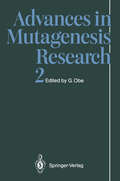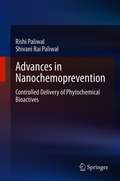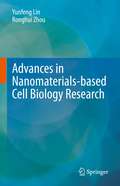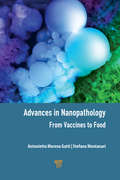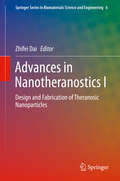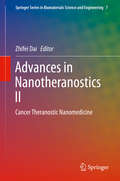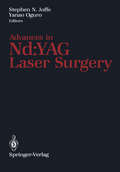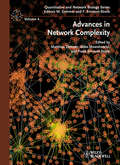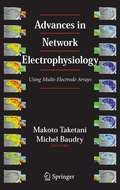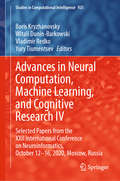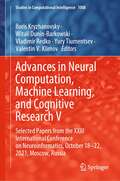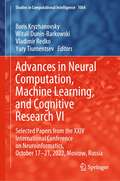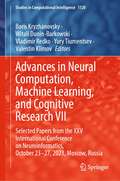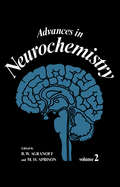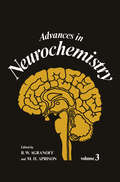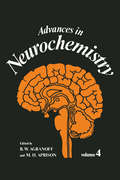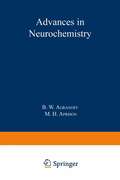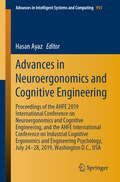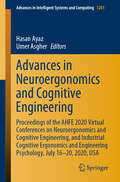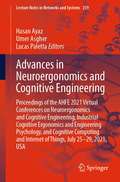- Table View
- List View
Advances in Mutagenesis Research 2 (Advances in Mutagenesis Research #2)
by E. E. Castilla R. Drouin J. Filipski E. Gebhart G. P. Holmquist P. Kasper J.S. Lopez-Camelo S. Madle K. Müller L. Müller J. Piper J. Pohl-Rüling C. L. Richer T.M. Schroeder-Kurth R. SodThe new field of applied genetic research, genetic toxicology and mutation research investigates the muta- genicity and cancerogenicity of chemicals and other agents. Permanent changes in genes and chromosomes, or genome mutations, can be induced by a plethora of agents, including ionizing and nonionizing radiations, chemicals, and viruses. Mutagenesis research has two aims: (1) to understand the molecular mechanisms leading to mutations, and (2) to prevent a thoughtless introduction of mutagenic agents into our environment. Both aspects, namely, basic and applied, will be treated in the new series Advances in Mutagenesis Research.
Advances in Myocardiology: Volume 4
by E. Chazov V. Saks G. RonaThis volume of Advances in Myocardiology is derived from a part of the proceedings of the 10th Congress of the International Society for Heart Research, which was held in Moscow on September 23-29, 1980. This book contains selected papers which have been arranged in two sections, Cardiac Hypertrophy, Adaptation, and Pathophysiology and Cardiac Hypoxia, Is chemia, and Infarction. The first section, on the pathophysiology of heart hypertrophy and failure, contains 24 chapters that focus on the derangement of biochemical, physiological, and immunological processes during the de velopment of heart disease due to a wide variety of pathogenic factors. Some of the recent developments in understanding the myocardial synthetic ma chinery in heart hypertrophy are also described in these papers, and we believe that the contents of this section will stimulate further research in the area of heart disease. The second section, which mainly deals with myocardial ischemia, contains 35 chapters providing the necessary back ground for the diagnosis of ischemic heart disease and some possible ther apeutic approaches. It hardly needs to be emphasized that ischemic heart disease is a major cause of death in highly industrialized countries, but unfortunately the exact mechanism by which ischemic insult leads to the development of heart cell damage is far from understood. We are hopeful that the articles in this section will provide valuable information in this field and thus will help in improving the treatment of ischemic heart disease.
Advances in Myocardiology (Advances in Mycocardiology)
by Peter HarrisThe Eleventh World Congress of the International Society for Heart Re search 1983 provided an opportunity to review some of the growing points in our knowledge of the structure and function of the myocardium. Those at the meeting will recall how London suddenly went tropical. Yet aseries of scintillating reviews held over six hundred scientists captive in the lecture halls of Imperial College. There were sessions on nuclear magnetic reso nance, the molecular basis of electrophysiology, calmodulin, protein syn thesis and degradation, oxygen free radicals, the structural components of the myocyte, sarcolemmal sodium exchange, and the influence of lipids on membranes. Here we have gathered together, as quickly as possible, a number of the presentations of the speakers invited to the symposia. They give, we believe, a striking picture ofthe diversity oftechnology and scientific enquiry which underlies this immensely active domain of modern cardiology. If only our clinical colleagues were more aware of it! Peter Harris Philip A. Poole-Wilson London v Contents Evolution, Cardiac Failure, and Water Metabolism: Presidential Address . . . . . . . . . . . . . . . . . . .
Advances in Nail Disease and Management (Updates in Clinical Dermatology)
by Robert L. BaranThis book serves as a concise text on nail diseases and disorders, offering the most up to date information available from internationally recognized speakers and authors. This comprehensive guide examines a multitude of nail disease types manifestations, treatments, and complications. Chapters delve into specific disorders such as yellow nail syndrome, psoriasis, lichen planus, and brittle nails. Notable treatments covered include advances in MRI, anti-neoplastic drugs and ultrasound imaging. The book also features discussions on unique topics, such as the convergence of orthopedics and onychology in nail disease treatment, as well as treatment complications faced by distinct demographics. Going beyond basics and diving right into the heart of various diseases and disorders, Advances in Nail Disease and Management will serve to aid experienced dermatologists looking for advanced expertise information.
Advances in Nanochemoprevention: Controlled Delivery of Phytochemical Bioactives
by Rishi Paliwal Shivani Rai PaliwalThis book discusses the recent progress and advances in nanochemoprevention. Chemoprevention utilizes natural dietary compounds and has regained interest due to larger safety window and proven efficacy of such molecules in cancer treatments. Nanotechnology has revolutionized drug delivery through passive as well as active targeting. This book provides a comprehensive overview of phytochemical bioactives that are used in chemoprevention. It gives a comprehensive overview of the variety of natural molecules and types of nanoparticles as well as mechanistic aspects of their superior efficacy over plain drug molecules. The book concludes with summarizing the progress of pre-clinical results of developed formulations for cancer treatment using nano-chemoprevention.
Advances in Nanomaterials-based Cell Biology Research
by Yunfeng Lin Ronghui ZhouThis book aims to comprehensively summarize the current research status of nanomaterials and cell biology. It highlights the biological effects and biomedical applications of nanomaterials for specific diseases, bone tissue engineering, and skeletal muscle regeneration. It also provides the details of the biomedical applications of nucleic acid nanomaterials in drug delivery carriers, antimicrobial therapy, vaccine, and neurodegenerative diseases. Therefore, this book renders the audience a better understanding of nanomaterials along with the diverse applications in the cell biology field from recent works to perspectives.
Advances in Nanopathology: From Vaccines to Food
by Antonietta Morena Gatti Stefano MontanariIf observed from an objective, epistemological standpoint, medicine is not a science, at least not in its own right. The most important, key feature missing is repeatability, which makes the doctor’s job extremely difficult. Doctors are not scientists but are called upon to use the results of scientific research every day. Therefore, they must keep themselves updated, distinguish what is worth extricating from a huge amount of literature and use the data exclusively in the patients’ interest. To be effective, medicine must start from a correct, full understanding of problems, but particulate pollution leads to too many wrong diagnoses. This book, written by the discoverers of nanopathology, is the most advanced in the field. It focuses on how natural, occasionally generated, engineered particles interfere with living organisms, food, drugs and the environment. It represents a bridge between environmental pollution and its impact on human/animal/plant health. Also unique is its new bioengineering-interdisciplinary approach to medicine and solving pathologies of unknown aetiology. It is a valuable aid for medical doctors in their diagnoses of pathologies triggered by nanoparticles internalized in the human/animal/plant body. They will find solutions to some hardly understandable symptoms which some patients report.
Advances in Nanopathology: From Vaccines to Food
by Antonietta Morena Gatti Stefano MontanariIf observed from an objective, epistemological standpoint, medicine is not a science, at least not in its own right. The most important, key feature missing is repeatability, which makes the doctor’s job extremely difficult. Doctors are not scientists but are called upon to use the results of scientific research every day. Therefore, they must keep themselves updated, distinguish what is worth extricating from a huge amount of literature and use the data exclusively in the patients’ interest. To be effective, medicine must start from a correct, full understanding of problems, but particulate pollution leads to too many wrong diagnoses. This book, written by the discoverers of nanopathology, is the most advanced in the field. It focuses on how natural, occasionally generated, engineered particles interfere with living organisms, food, drugs and the environment. It represents a bridge between environmental pollution and its impact on human/animal/plant health. Also unique is its new bioengineering-interdisciplinary approach to medicine and solving pathologies of unknown aetiology. It is a valuable aid for medical doctors in their diagnoses of pathologies triggered by nanoparticles internalized in the human/animal/plant body. They will find solutions to some hardly understandable symptoms which some patients report.
Advances in Nanotheranostics I: Design and Fabrication of Theranosic Nanoparticles (Springer Series in Biomaterials Science and Engineering #6)
by Zhifei DaiThis book highlights the recent advances in nanotheranostics from basic research to potential applications, and discusses the modular design and engineering of multiplex nanoparticles including gold nanostructures, luminescent nanoparticles, dendrimers and liposomes. Each chapter demonstrates multifunctional nanoparticles with topics covering targeting, imaging, delivery, diagnostics, and therapy as new modalities for cancer theranostics. This comprehensive book presents expert views on the latest developments in theranostic nanomedicine. It focuses on potential theranostic applications of multifunctional nanoparticles ranging from identifying noninvasively cancer cells by molecular detection, and visualizing in vivo drug delivery by means of contrast enhanced imaging, to destroying cancer cell s with minimal side effects via selective accumulation at tumor sites, and real-time monitoring therapeutic effectiveness. It also presents an interdisciplinary survey of nanotheranostics and as such is a valuable resource for researchers and students in related fields. Zhifei Dai is a Professor at the Department of Biomedical Engineering, College of Engineering, Peking University, China.
Advances in Nanotheranostics II: Cancer Theranostic Nanomedicine (Springer Series in Biomaterials Science and Engineering #7)
by Zhifei DaiThis book surveys recent advances in theranostics based on magnetic nanoparticles, ultrasound contrast agents, silica nanoparticles and polymeric micelles. It presents magnetic nanoparticles, which offer a robust tool for contrast enhanced MRI imaging, magnetic targeting, controlled drug delivery, molecular imaging guided gene therapy, magnetic hyperthermia, and controlling cell fate. Multifunctional ultrasound contrast agents have great potential in ultrasound molecular imaging, multimodal imaging, drug/gene delivery, and integrated diagnostics and therapeutics. Due to their diversity and multifunctionality, polymeric micelles and silica-based nanocomposites are highly capable of enhancing the efficacy of multimodal imaging and synergistic cancer therapy.This comprehensive book summarizes the main advances in multifunctional nanoprobes for targeted imaging and therapy of gastric cancer, and explores the clinical translational prospects and challenges. Although more research is needed to overcome the substantial obstacles that impede the development and availability of nanotheranostic products, such nontrivial nanoagents are expected to revolutionize medical treatments and help to realize the potential of personalized medicine to diagnose, treat, and follow-up patients with cancer. Zhifei Dai is a Professor at the Department of Biomedical Engineering, College of Engineering, Peking University, China.
Advances in Network Complexity (Quantitative and Network Biology (VCH))
by Matthias Dehmer Abbe Mowshowitz Frank Emmert-StreibA well-balanced overview of mathematical approaches to complex systems ranging from applications in chemistry and ecology to basic research questions on network complexity. Matthias Dehmer, Abbe Mowshowitz, and Frank Emmert-Streib, well-known pioneers in the fi eld, have edited this volume with a view to balancing classical and modern approaches to ensure broad coverage of contemporary research problems. The book is a valuable addition to the literature and a must-have for anyone dealing with network compleaity and complexity issues.
Advances in Network Complexity (Quantitative and Network Biology (VCH))
by Matthias Dehmer Abbe Mowshowitz Frank Emmert-StreibA well-balanced overview of mathematical approaches to complex systems ranging from applications in chemistry and ecology to basic research questions on network complexity. Matthias Dehmer, Abbe Mowshowitz, and Frank Emmert-Streib, well-known pioneers in the fi eld, have edited this volume with a view to balancing classical and modern approaches to ensure broad coverage of contemporary research problems. The book is a valuable addition to the literature and a must-have for anyone dealing with network compleaity and complexity issues.
Advances in Network Electrophysiology: Using Multi-Electrode Arrays
by Makoto Taketani Michel BaudryAdvances in Network Electrophysiology: Using Multi Electrode Arrays explores methods for using electrophysiological techniques for monitoring the concurrent activity of ensembles of single neurons. It reviews the recent progress in both electronics and computational tools developed to analyze the functional operations of large ensembles of neurons using multi-electrode arrays and in vitro preparations. In addition, it gives readers a sense of the applications made possible by these technological tools. This volume is the reference for researchers, industry, graduate students, and postdoctoral fellows in all areas of neuroscience, cognitive neuroscience, pharmaceutical science, and bioengineering.
Advances in Neural Computation, Machine Learning, and Cognitive Research IV: Selected Papers from the XXII International Conference on Neuroinformatics, October 12-16, 2020, Moscow, Russia (Studies in Computational Intelligence #925)
by Boris Kryzhanovsky Witali Dunin-Barkowski Vladimir Redko Yury TiumentsevThis book describes new theories and applications of artificial neural networks, with a special focus on answering questions in neuroscience, biology and biophysics and cognitive research. It covers a wide range of methods and technologies, including deep neural networks, large scale neural models, brain computer interface, signal processing methods, as well as models of perception, studies on emotion recognition, self-organization and many more. The book includes both selected and invited papers presented at the XXII International Conference on Neuroinformatics, held on October 12-16, 2020, Moscow, Russia.
Advances in Neural Computation, Machine Learning, and Cognitive Research V: Selected Papers from the XXIII International Conference on Neuroinformatics, October 18-22, 2021, Moscow, Russia (Studies in Computational Intelligence #1008)
by Boris Kryzhanovsky Witali Dunin-Barkowski Vladimir Redko Yury Tiumentsev Valentin V. KlimovThis book describes new theories and applications of artificial neural networks, with a special focus on answering questions in neuroscience, biology and biophysics and cognitive research. It covers a wide range of methods and technologies, including deep neural networks, large scale neural models, brain computer interface, signal processing methods, as well as models of perception, studies on emotion recognition, self-organization and many more. The book includes both selected and invited papers presented at the XXIII International Conference on Neuroinformatics, held on October 18-22, 2021, Moscow, Russia.
Advances in Neural Computation, Machine Learning, and Cognitive Research VI: Selected Papers from the XXIV International Conference on Neuroinformatics, October 17-21, 2022, Moscow, Russia (Studies in Computational Intelligence #1064)
by Boris Kryzhanovsky Witali Dunin-Barkowski Vladimir Redko Yury TiumentsevThis book describes new theories and applications of artificial neural networks, with a special focus on answering questions in neuroscience, biology and biophysics and cognitive research. It covers a wide range of methods and technologies, including deep neural networks, large-scale neural models, brain–computer interface, signal processing methods, as well as models of perception, studies on emotion recognition, self-organization and many more. The book includes both selected and invited papers presented at the XXIV International Conference on Neuroinformatics, held on October 17–21, 2022, in Moscow, Russia.
Advances in Neural Computation, Machine Learning, and Cognitive Research VII: Selected Papers from the XXV International Conference on Neuroinformatics, October 23-27, 2023, Moscow, Russia (Studies in Computational Intelligence #1120)
by Boris Kryzhanovsky Witali Dunin-Barkowski Vladimir Redko Yury Tiumentsev Valentin KlimovThis book describes new theories and applications of artificial neural networks, with a special focus on answering questions in neuroscience, biology and biophysics and cognitive research. It covers a wide range of methods and technologies, including deep neural networks, large-scale neural models, brain–computer interface, signal processing methods, as well as models of perception, studies on emotion recognition, self-organization and many more. The book includes both selected and invited papers presented at the XXV International Conference on Neuroinformatics, held on October 23-27, 2023, in Moscow, Russia.
Advances in Neurochemistry (Cellular Organelles)
by B. W. Agranoff M. H. AprisonIn the Preface to Volume 1, we stated: This series recognizes that investigators who have entered neurochemistry from the biochemical tradition have a rather specialized view of the brain. Too often, interdisci plinary offerings are initially attractive but turn out to recite basic biochemical considera tions. We have come to believe that there are now sufficiently large numbers of neurochemists to support a specialized venture such as the present one. We have begun with consideration of traditional areas of neurochemistry which show considerable scientific activity. We hope they will serve the neurochemist both for general reading and for specialized information. The reader will also have the opportunity to reflect on the unbridled speculation that results from the disinhibiting effects on the author who has been invited to write a chapter. We plan occasionally also to offer reviews of areas not completely in the domain of neurochemistry which we nevertheless feel to be sufficiently timely to be called to the attention of all who use chemical principles and tools in an effort to better understand the brain. The contributions to the present volume pursue these goals. We believe the series has set high standards and has continued to uphold them. In accordance with the principle stated in the last paragraph of the Preface Volume 1, we include in this volume Koshland's "Sensory Response in Bacteria" (Chapter 5).
Advances in Neurochemistry: Volume 3
by B. W. Agranoff M. H. AprisonThe original premise of the Editors in initiating this series was that there existed a readership ofneurochemists with considerable biochemical back ground who would make use of a series dedicated to both new develop ments and specialized reviews in neurochemistry. Having selected our authors, we have offered them virtually complete freedom to reflect and speculate in a field in which they have achieved prominence. The response to the first two volumes has been rewarding. The present one continues in this tradition. While we have not attempted to publish specialized volumes, the present volume contains two somewhat related chapters (Chapters 4 and 5, on the role of amino acid neurotransmitters). The first three chapters examine three diverse approaches, each of current interest, in neurochemi cal approaches to the molecular bases of neuronal and glial structure. B. W. Agranoff M. H. Aprison vii CONTENTS CHAPTER 1 2',3'-CYCUC NUCLEOTIDE 3'-PHOSPHODIESTERASE NEIL RAYMOND SIMS AND PATRICK ROBERT CARNEGIE 1. Introduction. . . . . . . . . . . . . . . . . . . . . . . . . . . . . . . . . . . . . . . . . . . . 1 2. Assay of CNPase . . . . . . . . . . . . . . . . . . . . . . . . . . . . . . . . . . . . . . . 3 2. 1. Need for Activation. . . . . . . . . . . . . . . . . . . . . . . . . . . . . . . . 3 2. 2. Comparison of Assays . . . . . . . . . . . . . . . . . . . . . . . . . . . . . . 3 3. Association of CNPase with Myelin . . . . . . . . . . . . . . . . . . . . . . . 7 3. 1. Historical. . . . . . . . . . . . . . . . . . . . . . . . . . . . . . . . . . . . . . . . . 7 3. 2. Subcellular Fractionation. . . . . . . . . . . . . . . . . . . . . . . . . . . . 8 3. 3. Development. . . . . . . . . . . . . . . . . . . . . . . . . . . . . . . . . . . . . . 8 3. 4. Mutant Mice . . . . . . . . . . . . . . . . . . . . . . . . . . . . . . . . . . . . . . 9 3. 5. Use as a Myelin Marker . . . . . . . . . . . . . . . . . . . . . . . . . . . . 10 3. 6. Myelin-Related Fractions and Peripheral Nerve Myelin. 11 4. CNPase in Nonmyelin Fractions. . . . . . . . . . . . . . . . . . . . . . . . . . 13 5. Activation and Isolation. . . . . . . . . . . . . . . . . . . . . . . . . . . . . . . . . . 13 5. 1. Introduction. . . . . . . . . . . . . . . . . . . . . . . . . . . . . . . . . . . . . . . 13 5. 2. Activation. . . . . . . . . . . . . . . . . . . . . . . . . . . . . . . . . . . . . . . . . 14 5. 3. Solubilization and Fractionation. . . . . . . . . . . . . . . . . . . . . . 15 6. Properties. . . . . . . . . . . . . . . . . . . . . . . . . . . . . . . . . . . . . . . . . . . . . . 19 6. 1. Substrate Specificity. . . . . . . . . . . . . . . . . . . . . . . . . . . . . . . .
Advances in Neurochemistry (Advances in Neurochemistry #4)
by B. W. Agranoff M. H. AprisonThis series has been directed at providing scientists possessing considerable bio chemical background with specialized reviews of neurobiological interest. Some have dealt with completed bodies of research, while others consist of extensive reports of research in progress, judged to be of current interest to the active researcher. We have selected recognized scientists and allowed them freedom to reflect and speculate in the field in which they have achieved prom inence. We note with sadness the passing of Dr. 10rdi FoIch-Pi, who served as an advisory editor when the series was initiated. He played a central role in the development of neurochemistry, as well as the creation of professional societies and journals. He will be remembered fondly by all those whose lives he touched. The editors acknowledge the cooperation of the Upjohn Company in the preparation of the color plate included in this volume. We also acknowledge the skillful editorial assistance of Dr. Kenneth C. Leskawa. We are pleased to honor the retirement of Dr. E. Martin Gal, a former advisory editor of Advances, with the inclusion of a chapter by him in this volume.
Advances in Neurochemistry
by B. W. Agranoff M. H. AprisonThe emergence of a new scientific book series requires some explanation regarding how it hopes to compensate the reader for the discomforts it undoubtedly produces both in the realms of informational input-overload and in the financial strain on personal and institutional budgets. This series recognizes that investigators who have entered neurochemistry from the biochemical tradition have a rather specialized view of the brain. Too often, interdisciplinary offerings are initially attractive but turn out to recite basic biochemical considerations. We have come to believe that there are now sufficiently large numbers of neurochemists to support a specialized venture such as the present one. We have begun with consideration of traditional areas of neurochemistry which show considerable scientific activity. We hope they will serve the neurochemist both for general reading and for specialized information. The reader will also have the opportunity to reftect on the unbridled speculation that results from the disinhibiting effects on the author who has been invited to write a chapter. We plan occasionally also to offer reviews of areas not completely in the domain of neurochemistry which we nevertheless feel to be sufficiently timely to be called to the attention of all who use chemical principles and tools in an effort to better understand the brain. B. W. Agranoff M. H. Aprison vii CONTENTS CHAPTER 1 POSSIBLE ROLES OF PROSTAGLANDINS IN THE NERVOUS SYSTEM LEONHARD S. WOLFE 1. Introduction 1 1. 1. Background 1 Names and Structures 1. 2. 4 1. 3. Biosynthesis 4 1. 4.
Advances in Neuroergonomics and Cognitive Engineering: Proceedings of the AHFE 2019 International Conference on Neuroergonomics and Cognitive Engineering, and the AHFE International Conference on Industrial Cognitive Ergonomics and Engineering Psychology, July 24-28, 2019, Washington D.C., USA (Advances in Intelligent Systems and Computing #953)
by Hasan AyazThis book offers a broad perspective on the field of cognitive engineering and neuroergonomics, covering emerging practices and future trends toward the harmonious integration of human operators and computer systems. It presents novel theoretical findings on mental workload and stress, activity theory, human reliability, error and risk, and neuroergonomic measures alike, together with a wealth of cutting-edge applications. Further, the book describes key advances in our understanding of cognitive processes, including mechanisms of perception, memory, reasoning, and motor response, with a special emphasis on their role in interactions between humans and other elements of computer-based systems. Based on the AHFE 2019 affiliated conference on Neuroergonomics and Cognitive Engineering, held on July 24-28, 2019, in Washington D.C., USA, it provides readers with a comprehensive overview of the current challenges in cognitive computing and factors influencing human performance.
Advances in Neuroergonomics and Cognitive Engineering: Proceedings of the AHFE 2020 Virtual Conferences on Neuroergonomics and Cognitive Engineering, and Industrial Cognitive Ergonomics and Engineering Psychology, July 16-20, 2020, USA (Advances in Intelligent Systems and Computing #1201)
by Hasan Ayaz Umer AsgherThis book offers broad overview of the field of cognitive engineering and neuroergonomics, covering emerging practices and future trends toward the harmonious integration of human operators and computer systems. It presents novel theoretical findings on mental workload and stress, activity theory, human reliability, error and risk, and a wealth of cutting-edge applications, such as strategies to make assistive technologies more user-oriented. Further, the book describes key advances in our understanding of cognitive processes, including mechanisms of perception, memory, reasoning, and motor response, with a particular focus on their role in interactions between humans and other elements of computer-based systems. Gathering the proceedings of the AHFE 2020 Virtual Conferences on Neuroergonomics and Cognitive Engineering, and Industrial Cognitive Ergonomics and Engineering Psychology, held on 16–20 July 2020, this book provides extensive and timely information for human–computer interaction researchers, human factors engineers and interaction designers, as well as decision-makers.
Advances in Neuroergonomics and Cognitive Engineering: Proceedings of the AHFE 2021 Virtual Conferences on Neuroergonomics and Cognitive Engineering, Industrial Cognitive Ergonomics and Engineering Psychology, and Cognitive Computing and Internet of Things, July 25-29, 2021, USA (Lecture Notes in Networks and Systems #259)
by Hasan Ayaz Umer Asgher Lucas PalettaThis book offers a broad overview of the field of cognitive engineering and neuroergonomics, covering emerging practices and future trends toward the harmonious integration of human operators and computational systems. It gathers both theoretical and practice-oriented studies on mental workload and stress, activity theory, human reliability, error and risk. It covers applications in various field, and corresponding strategies to make assistive technologies more user-oriented. Further, the book describes key advances in our understanding of cognitive processes, including mechanisms of perception, memory, reasoning, and motor response, with a particular focus on their role in interactions between humans and other elements of computer-based systems. Gathering the proceedings of the AHFE 2021 Conferences on Neuroergonomics and Cognitive Engineering, Industrial Cognitive Ergonomics and Engineering Psychology, and Cognitive Computing and Internet of Things, held virtually on July 25-29, 2021, from USA, this book offers extensive information and a thought-provoking guide for researchers and practitioners in cognitive engineering, neuroergonomics and their applications.
